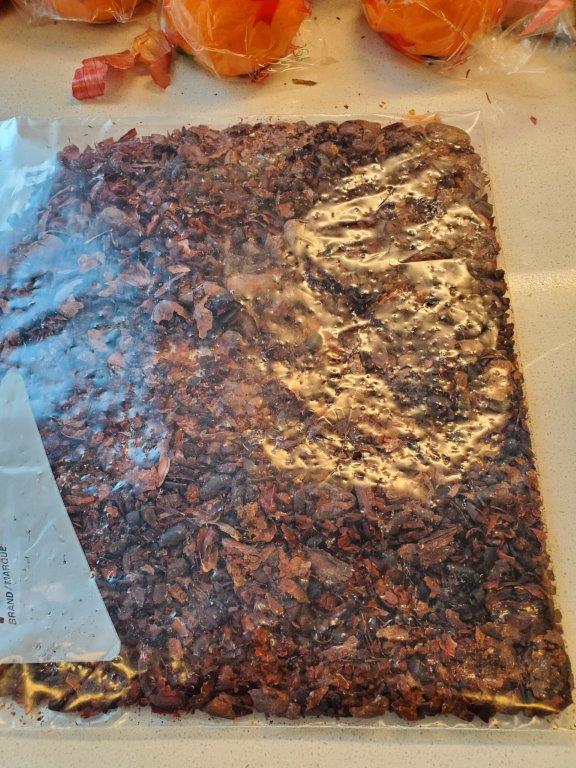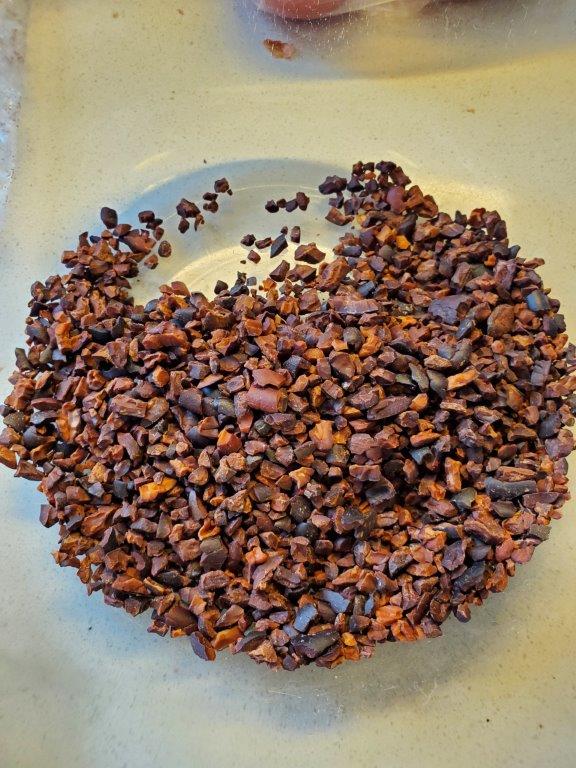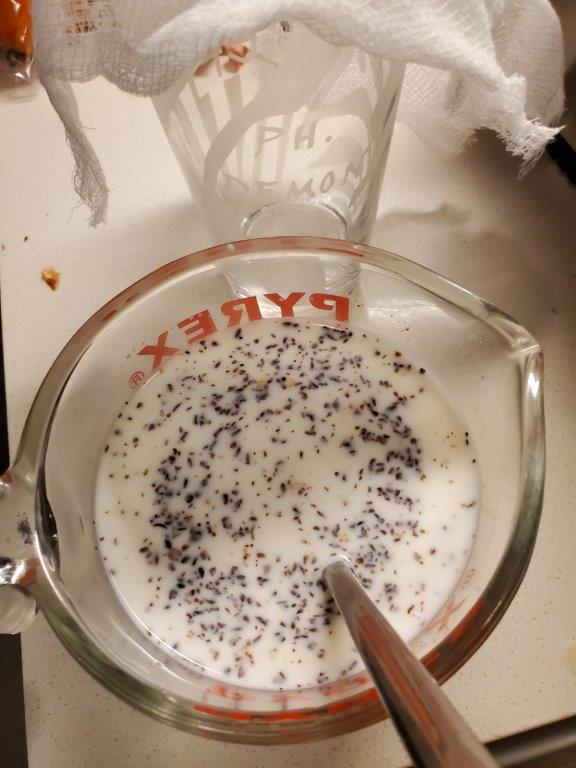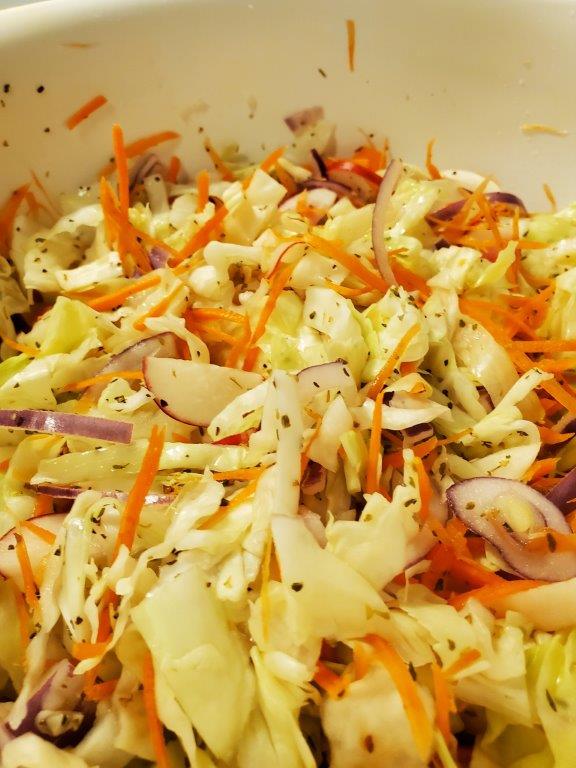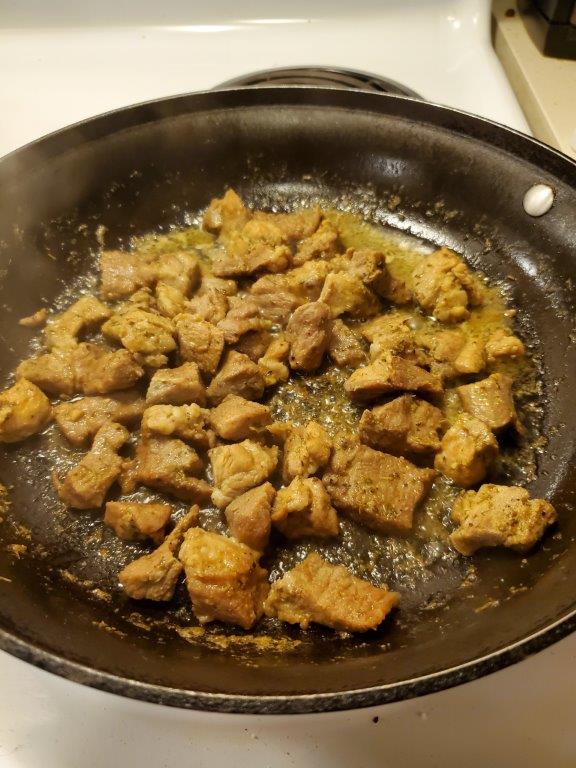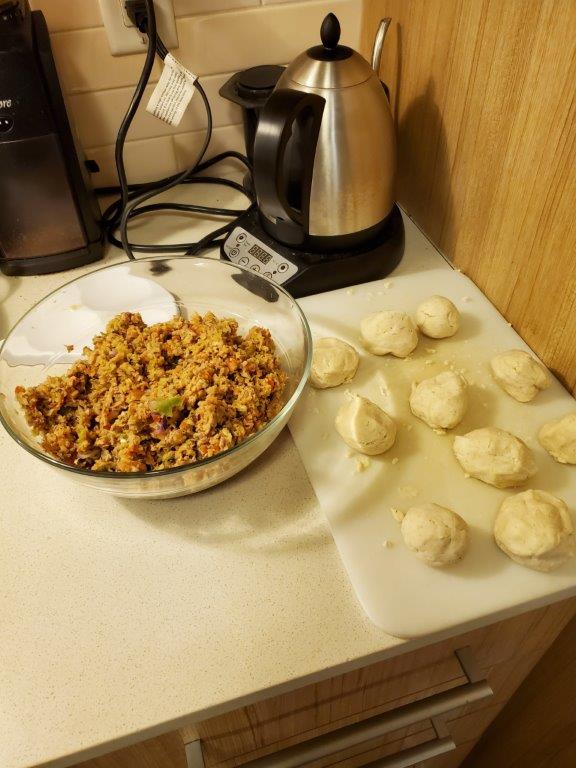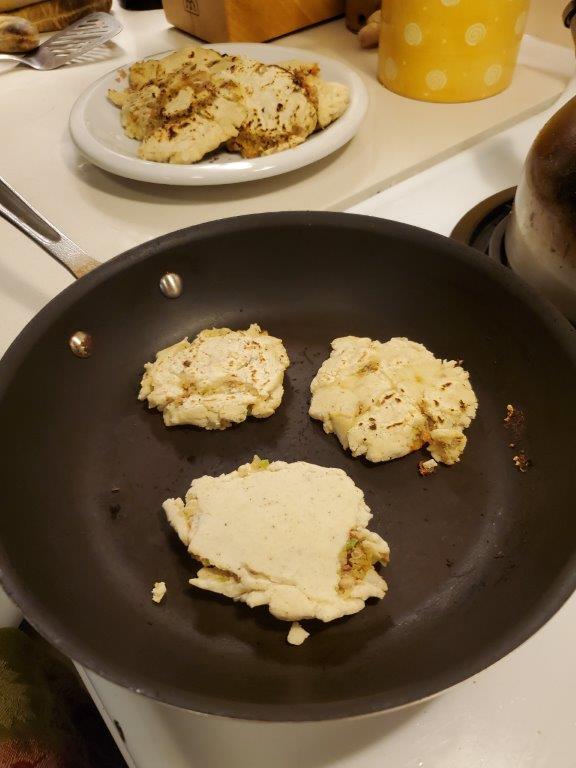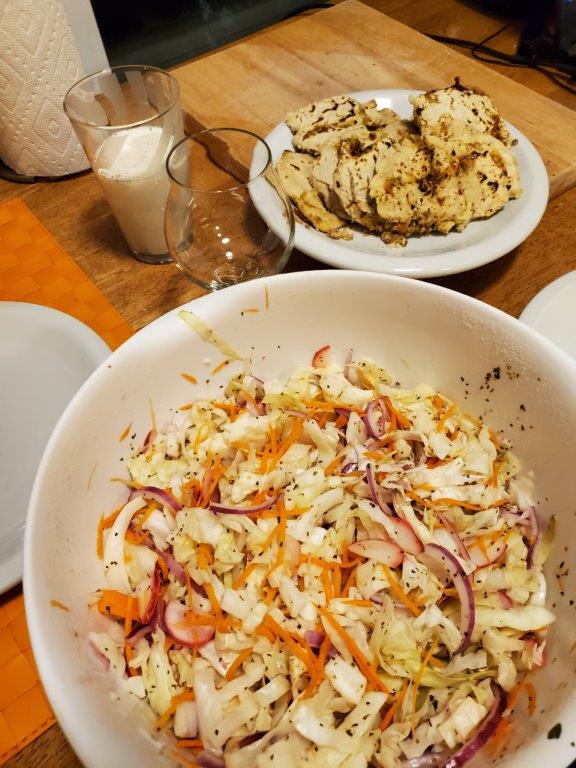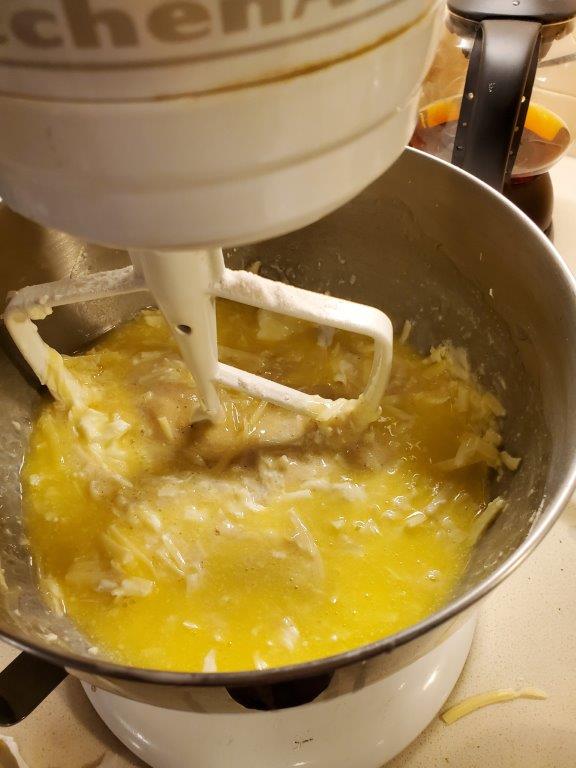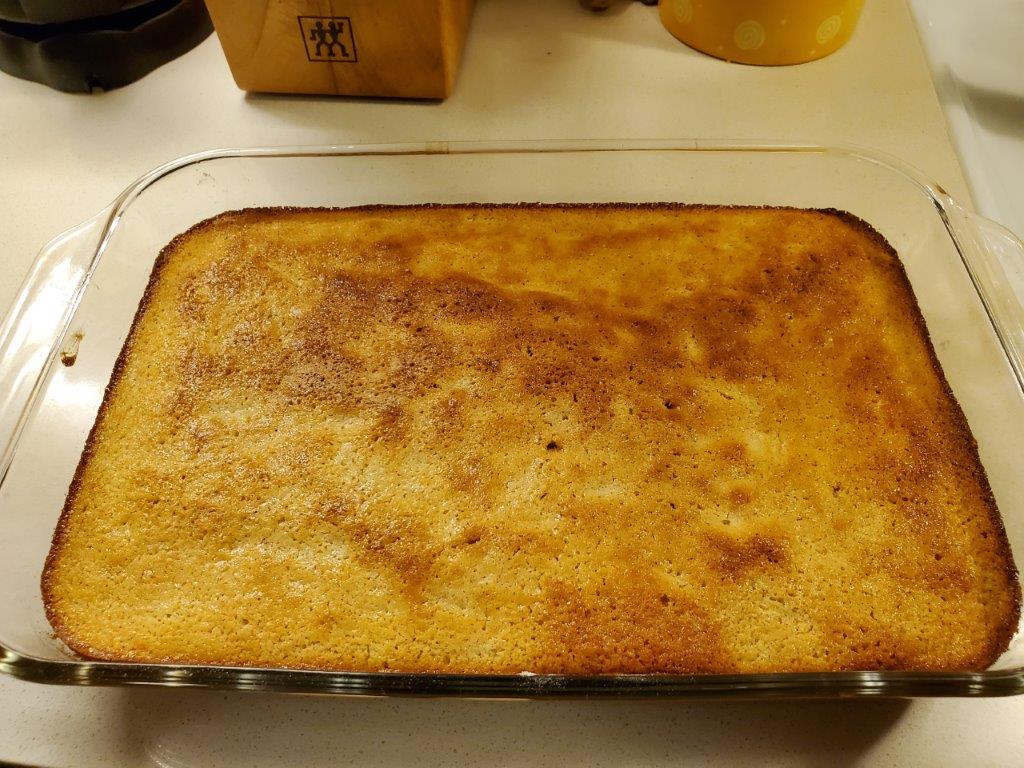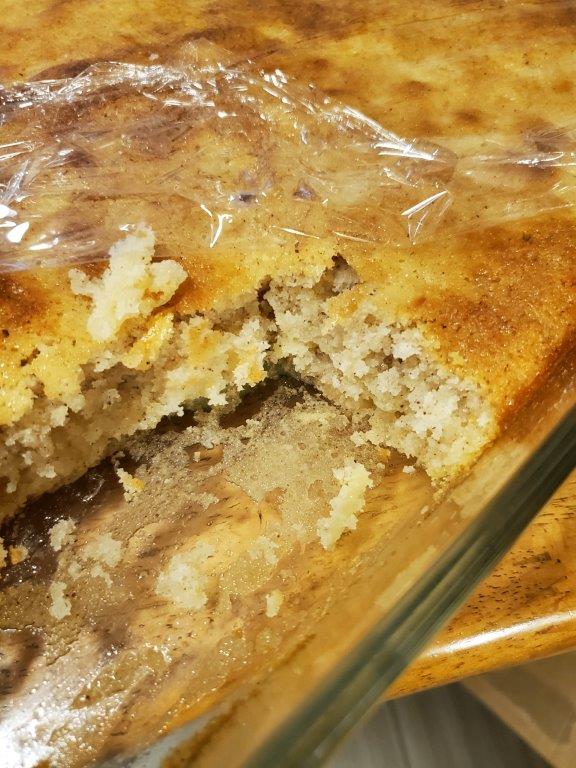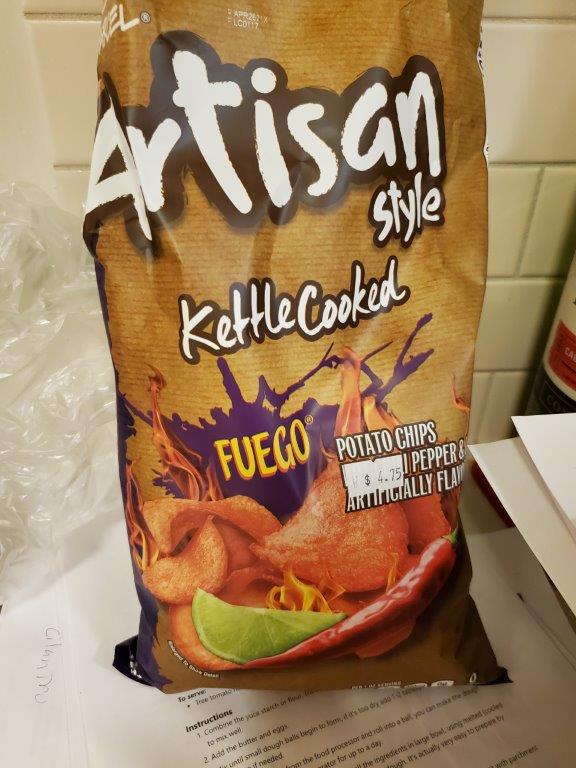El Salvador… could have gone better. It was fine, but certainly not our best effort. It’s unclear to me whether that’s a result of not picking the best recipes, or not executing them well. Y’all can judge for yourselves as we go along.
We’ve actually had Salvadoran food before, and it was a no-brainer to choose their best known culinary export – Pupusas. Pupusas are somewhere between a tamale and a stuffed pancake – they’re a griddled disk made from corn meal with a savory filling. They’re great if done well. To accompany the Pupsas, we made a side salad/topping called curtido, as well as horchata and a quesadilla.
“Ah ha!”, you may be thinking, “I am familiar with both of those last two.” Well, if you’re familiar with the Mexican versions, the Salvadoran ones are just a bit and extremely different, respectively.
To start, I went to the Hispanic grocery store near my office, where they were quite helpful, but also pointed out that they had pupusas and Salvadoran horchata mix ready made, and was I sure I really wanted to try to do both from scratch?
Sure – how hard can it be? After all horchata is just flavored sugar rice milk, right?
No, that’s Mexican horchata. Salvadoran horchata uses juuuuust a few more ingredients.
No seriously. From upper left, that’s coriander seed, rice, cinnamon, whole nutmeg, sesame seeds, morro seeds, pumpkin seeds, allspice berries, cocoa beans, and peanuts. (The little red tupperware is just more sesame seeds.)
Every single one of these ingredients except the cinnamon powder has to be toasted, and toasted one at a time, because they all cook differently. Fortunately, the peanuts and sesame seeds can be purchased already toasted. But one at a time, into the wok went coriander, nutmeg, allspice, rice, pumpkin seeds, and morro seeds.
“What the hell are morro seeds?”, I hear you asking. Apparently, they are a seed that has no business existing any more, because they can only germinate if a large animal breaks their fruit open, and there are no longer any native animals capable of doing so. Horses and humans are the morro’s best friend at this point.
And finally, we come to the cocoa beans. Have you ever wondered why we don’t make chocolate at home from scratch? Well, there’s a reason. First, the beans have to be roasted like coffee beans. And like coffee beans, there’s a thin margin between raw and burnt
The good news is that UNLIKE coffee beans, the fumes are a lot less nasty if you try to roast them in your oven. Once you’ve done that, however, you’re still faced with the problem that the husk is inedible. So you put the beans in a plastic bag and smash them a bit:
Then you have to somehow separate the chaff from the tasty center bit. The recommended tool for this job for home chefs appears to be a hair dryer, I kid you not.
I’m pretty sure quite a bit of actual chocolate ended up on our patio, but after a while, we had a bowl of probably more-or-less pure cocoa nibs.
Note that if you actually want to make CHOCOLATE from this point, there are still like six more steps. I actually did make a couple of very basic truffles with the extra beans, but it just drove home that no, making chocolate from scratch is not a good choice.
Now that we finally had all of our ingredients ready, everything went into the food processor to make a powder. It made a LOT of powder. Not for the first time this evening, the recipe made a LOT more of the thing than claimed. At 1 tablespoon per serving, this is way more than 15 servings of horchata powder.
To actually MAKE the horchata, you put the powder in cold milk with some sugar and vanilla, let it soak for a while, then strain out the solids through a cheesecloth. (Ph.Demon mug courtesy of Flint Roller Derby.)
We discovered later on that a French press works much more easily than the cheesecloth. Good thing, because we have A METRIC TON of horchata mix. (It has to be metric – we’re in Canada.)
Backing up a bit in time, let’s talk about the curtido, which we made the night before. It’s basically a tangy coleslaw made with cabbage and vinegar. What distinguishes the Salvadoran version, according to most of the sources we consulted, is the addition of quite a bit of radish. The fact that the particular recipe we were using DIDN’T call for radish might have been a red flag. We added some in anyway.
Don’t those look pretty? The final product looked good too, although I suspect it could have used a LOT more vinegar than the recipe called for.
OK, we can’t put this off any more – what about the actual pupsas? The method isn’t complicated. Brown some pork butt with a mix of seasonings, braise it for a bit in some water, then cook the water off until the pork turns crisp.
Then, to make a filling, toss the pork in the food processor with tomatoes, onions, and green pepper. The dough is even simpler – instant masa harina (corn flour) and some water. Mix into balls, and you’re ready to cook.
And here’s where we went wrong. Or the recipe went wrong. Or something. The pupusas I remember having in restaurants were hearty items five or so inches across.
This recipe does NOT make enough dough for anything that substantial. And it makes waaaaay more filling than could possibly fill the amount of dough it does make. But OK, let’s do the best we can. You flatten the dough, put some filling in the middle, bring the dough over to surround the filling, then flatten it out again.
Not a single one of our pupusas fully enclosed the filling. They were, to put it politely… rustic.
Still – they DID cook up nice and brown, with the small dark spots you expect.
And so this was our meal:
Not very much pupusas, a MOUNTAIN of curtido, and a glass of horchata.
And as I said at the outset, the pupusas were… fine. They tasted like pupusas. They just didn’t necessarily taste like GOOD pupusas. Certainly more salt might have helped, but more seasoning in general would have probably been welcome. The curtido was nice and crisp, but the vinegar to veggies ratio also seemed a bit off.
Fun fact: it turns out that one of the most common condiments in El Salvador is, for some reason, Worcestershire sauce, which is often referred to as “Salsa Inglés,” or “English Sauce.” Not having any of that, I slopped some Costa Rican “Salsa Lizano” on my pupusas, and that was delicious. Maybe not authentic, but delicious.
The best part was the horchata. The flavor was subtle, but definitely present, and more complex than the Mexican version.
Wait a minute – didn’t I say we made a quesadilla? Where was that?
It turns out in El Salvador, a quesadilla is a dessert. Back at the Mexican grocer, I showed the recipe to one of the employees. It said that Salvadoran cheese is very hard to find outside of the country, and suggested Parmesan. “Parmesan?” I thought? Surely one of these Mexican cheeses would be a better fit?
“Nope,” confirmed the clerk. “You’re better off with Parmesan.”
OK, Parmesan it is. Into some milk it went to soak while I separated some eggs, screwed up the last one, got yolk in the whites, tried to beat them anyway, realized that you REALLY CAN’T beat egg whites with fat in them, realized I had used the last 4 eggs, and sent Leigh off to the store to get some more.
Ahem.
Egg whites correctly separated and whipped up, from this point, you’re just making a cake; dry ingredients in one bowl, wet in another. Eggs, milk, butter, cinnamon, rice (!) flour, and baking powder. Mix it all together, trying not to knock the air back out of the egg whites.
And grated Parmesan. Unusual, to say the least. After baking, the quesadilla had a lovely color.
And was very spongy and tasty. It was DEFINITELY a new sensation getting chewy bits of Parmesan cheese in a sponge cake, but honestly, it worked. Good thing, too, because we’re going to be eating this thing for a week.
And that’s El Salvador. I have to say that we were a little disappointed. We’ve had Salvadoran food in restaurants before, and this just didn’t live up to it. I don’t know if it was a poor choice of recipes, ineptitude on our part (likely), or a combination of the two, but the whole meal seemed somewhat under seasoned.
Good thing we have a MOUNTAIN of leftovers. Actually, that IS a good thing – leftovers are always a plus, and we still have a nearly full jar of Salsa Lizano, after all!
Next time, we’re off to Equatorial Guinea, to start a run where 4 of the next 5 countries will be African. Stay tuned!
Recipes:
Salvadoran Pupusas de Chicharron with Curtido (This is the one we used, but I’m guessing you can do better.)
Salvadoran Horchata (Do NOT make this. Just buy the premade powder. Seriously. That is what actual Salvadorans in El Salvador do.)
Salvadoran Quesadilla
PS – if you buy these chips at the Mexican grocer and try to eat them on the way home, be forewarned that even if you eat a lot of spicy foods, and love spicy foods, these things are still really, really spicy. Don’t say we didn’t warn you.


